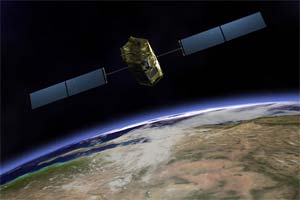NASA’s Orbiting Carbon Observatory satellite plunges into the ocean
25 Feb 2009
NASA's Orbiting Carbon Observatory, a satellite designed to monitor global carbon dioxide emissions, plummeted into the Pacific Ocean after a problem in the launch rocket prevented its separation from the satellite. NASA called it a major disappointment for climate science.
The satellite is believed to have crashed into the Pacific Ocean north of Antarctica.
 NASA said the satellite launched successfully from the Vandenberg Air Force Base in California aboard a Taurus XL rocket. But, a fatal error occurred minutes after liftoff when a fairing, a clamshell-like nose cone that protects the satellite during its ascent, failed to separate properly.
NASA said the satellite launched successfully from the Vandenberg Air Force Base in California aboard a Taurus XL rocket. But, a fatal error occurred minutes after liftoff when a fairing, a clamshell-like nose cone that protects the satellite during its ascent, failed to separate properly.
"The initial indications show that the vehicle did not have enough lift to reach orbit and landed short of Antarctica in the ocean," said John Brunschwyler, programme director for the Taurus rocket at Orbital Sciences Corporation.
"Our whole team at a very personal level are disappointed, we are very upset with the results," he said. Brunschwyler also noted that six out of seven Taurus rockets, launched between 1994 and 2004, have flown without any problems.
It was the first time NASA had used a Taurus rocket, which has had a nearly perfect record in previous flights with no issues with the fairing design.
NASA flight director Chuck Dovale called it "a huge disappointment" for the science community.
"The liftoff was smooth," said Jet Propulsion Laboratory spokesman Alan Buis. "It was pretty far along in the ascent" over the Pacific Ocean when the "contingency" was declared he said.
"Several minutes into the flight, launch managers declared a contingency when the fairing failed to separate properly," said a brief NASA statement.
Dovale said all indications were that all stages of the launch vehicle burned, so there should be no threat to the environment from the toxic hydrazine fuel on board. He also said an investigation board would be formed to determine the "probable cause" of the failure.
The Orbiting Carbon Observatory's (OCO) mission was to map the global distribution of carbon dioxide and study how it changes over time, according to NASA.
Carbon dioxide is the leading greenhouse gas driving climate change.
Though it was NASA's first space mission dedicated to studying carbon dioxide, it was not the first in orbit. Last month Japan launched the world's first satellite dedicated to monitoring greenhouse gas emissions.
Michael Freilich, director of NASA's science division, said it was not clear how long it might take to replace the OCO, which took eight years to develop.
"The science is moving forward so it's difficult to put a precise time delay on how quickly in the future we would be able to realise the understanding that OCO would have given us, having succeeded," says Freilich said.
The Japanese Greenhouse Gases Observing Satellite (GOSAT) mission aims to help scientists measure the density of carbon dioxide and methane from almost the entire surface of the earth, according to the Japan Aerospace Exploration Agency (JAXA).
The satellite is collecting data from 56,000 locations around the world, a dramatic increase from the 282 observation points available as of last October.













.jpg)






.jpg)









